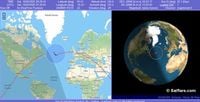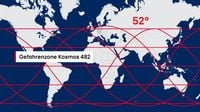The Soviet space probe Kosmos 482, which has been orbiting Earth since its launch in 1972, is on a collision course with our planet. Originally designed for a mission to Venus, the probe is expected to re-enter the atmosphere and crash on Saturday, May 10, 2025, after decades in space.
Launched on March 31, 1972, Kosmos 482 was intended to explore Venus, but a malfunction in the fourth stage of its launch rocket prevented it from escaping Earth's orbit. Instead of heading towards its target, the probe has been trapped in a high elliptical orbit around Earth for over five decades. It weighs approximately 495 kilograms and has a diameter of 1.17 meters, making it a sizable piece of space debris.
As the date of its expected crash approached, various space agencies, including Roskosmos and the European Space Agency (ESA), provided updates on the probe's trajectory. According to ESA, Kosmos 482 entered the Earth’s atmosphere at around 8:24 AM Central European Summer Time (CEST) on May 10, 2025, and subsequently crashed into the Indian Ocean, just west of Jakarta, Indonesia. This information aligns with earlier predictions, which had estimated its re-entry time with a margin of error.
Prior to its crash, the probe was tracked by radar systems over Germany between 6:30 AM and 8:04 AM on the same day. The ESA noted that the probe was not detected on radar at 9:32 AM CEST, suggesting that it had already re-entered the atmosphere. Roskosmos confirmed that Kosmos 482 no longer exists, marking the end of its long journey.
The probe was designed with a heat shield intended to protect it during atmospheric entry, which raised concerns about whether it would burn up upon re-entry. However, experts had speculated that due to the materials used in its construction, the probe could survive the descent and reach the Earth's surface intact. In fact, the probe was built to withstand extreme conditions, having been originally designed for a landing on Venus.
Despite the potential risks associated with falling space debris, the likelihood of any injuries or damages on the ground was considered minimal. The ESA indicated that the chances of Kosmos 482 causing harm were extremely low, as the Earth's surface is predominantly covered by water, and the risk of human injury from falling debris is less than one in a billion.
As Kosmos 482 made its final descent, the scientific community reflected on its historical significance. The probe was part of the Soviet Union's ambitious space program aimed at exploring Venus, which included several missions between 1961 and 1983. While Kosmos 482 never achieved its intended goal of landing on Venus, it served as a testament to the era's space exploration efforts.
The Venera program, of which Kosmos 482 was a part, successfully landed several probes on Venus, with Venera 7 being the first to transmit data from the planet's surface back to Earth in 1970. Venera 8 followed suit, sending information for 11 seconds before succumbing to the harsh conditions on Venus. Kosmos 482, however, failed to reach its destination due to a launch failure, leading to its long-term orbit around Earth.
As the world watched the events unfold, the re-entry of Kosmos 482 raised questions about space debris management and the increasing frequency of similar incidents. The ESA noted that nearly every day, satellites or rocket parts of moderate size fall back to Earth, yet significant damage from such events is rare. However, as space traffic increases, the potential for more frequent re-entries and related incidents also rises.
In conclusion, the story of Kosmos 482 serves as a reminder of the complexities and challenges of space exploration. While the probe's journey ended in the Indian Ocean, its legacy continues to influence discussions about the future of space missions and the management of debris in Earth's orbit.




